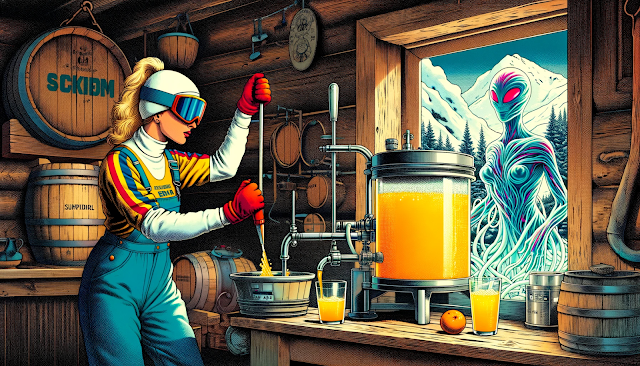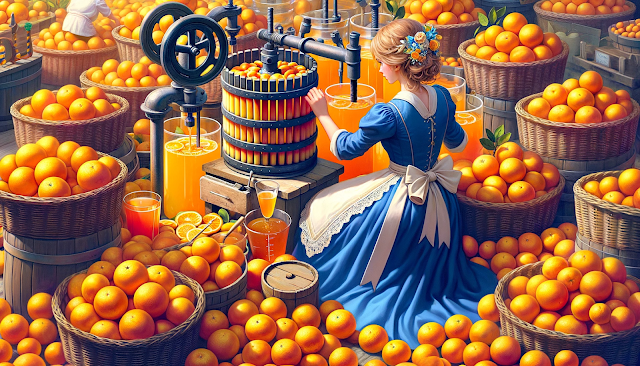Making alcohol from orange juice is indeed a captivating and rewarding process, grounded in the art of fermentation. This natural biochemical reaction is the cornerstone of how yeast, a microscopically small yet immensely powerful organism, transforms the sugars present in orange juice into alcohol and carbon dioxide.
The process is not just a simple chemical reaction; it's a blend of science, patience, and a touch of culinary artistry.
As you embark on this journey of creating your own homemade alcoholic beverage from orange juice, you'll be delving into a practice that dates back thousands of years, yet still holds a sense of wonder and discovery in today's DIY culture.
That's a of lot words to say we are making hooch!
The following guide outlines each step in this process, from selecting the right ingredients to the final joy of tasting your own crafted creation.
Understanding the Basics of turning orange into booze
Before you begin, it's important to understand a few key concepts:
- Fermentation: This is the process where yeast breaks down sugar in the absence of oxygen to produce alcohol and carbon dioxide.
- Yeast: A microorganism that is crucial for fermentation. Brewer's yeast is commonly used for alcoholic fermentation.
- Sanitation: Ensuring all equipment is sanitized is crucial to prevent unwanted bacteria from spoiling your brew.
Equipment Needed
- Fermentation vessel (such as a glass jar or food-grade plastic bucket)
- Airlock and stopper
- Hydrometer (optional, for measuring sugar content)
- Siphon or funnel
- Bottles for storage
- Sanitizing solution (like veryyyy diluted bleach or a no-rinse sanitizer)
Ingredients
- 100% pure orange juice without preservatives (preservatives can inhibit yeast growth)
- Sugar (if additional sweetness or higher alcohol content is desired)
- Brewer's yeast
Step-by-Step Process
1. Sanitization
- Sanitize all equipment: This includes the fermentation vessel, airlock, siphon, and bottles. Use a sanitizing solution and rinse thoroughly if not using a no-rinse sanitizer.
2. Preparing the Juice
- Mix orange juice and sugar (optional): If you want a sweeter taste or higher alcohol content, dissolve additional sugar into the orange juice. Use a hydrometer to measure the specific gravity, if desired, which can give you an estimate of potential alcohol content.
3. Adding Yeast
- Inoculate with yeast: Add the brewer's yeast to the juice. The quantity of yeast will depend on the amount of juice and desired fermentation speed. Typically, a packet of yeast (about 7 grams) is enough for a gallon of juice.
4. Fermentation
- Transfer to the fermentation vessel: Pour the juice-yeast mixture into your sanitized fermentation vessel.
- Seal with airlock: Fit the airlock into the stopper, then seal the vessel. The airlock allows carbon dioxide to escape while preventing air (and contaminants) from entering.
5. Fermentation Period
- Store in a suitable location: Place the vessel in a dark, cool place with a stable temperature. Ideal fermentation temperatures typically range between 18-24°C (64-75°F).
- Wait and monitor: Fermentation time can vary but usually takes about 1-2 weeks. Signs of fermentation include bubbling in the airlock and a cloudy appearance in the juice.
6. Bottling
- Check fermentation completion: Fermentation is complete when bubbling stops and the juice clears. A hydrometer can confirm if the fermentation has finished (the specific gravity will be stable over a couple of days).
- Siphon into bottles: Use a siphon to transfer the alcohol into sanitized bottles, being careful to leave sediment behind.
7. Aging and Storage
- Seal the bottles: Cap or cork the bottles.
- Store in a cool, dark place: The alcohol can be consumed immediately, but aging it for a few weeks can improve its taste.
8. Enjoy your creation!
- Serve chilled: Your homemade orange juice alcohol is ready to enjoy!
Notes and Tips
- Alcohol Content: The alcohol content will depend on the initial sugar content of the juice and any added sugar. Typically, you can expect an alcohol content of around 4-8%.
- Taste Variations: Experimenting with different types of oranges or adding other fruit juices can create unique flavor profiles.
- Tartness: In our experience, the product can be a bit tart, mixing with lemonade soda will counter this.
- Remember, the key to successful fermentation is patience and attention to detail, especially when it comes to sanitization and monitoring the fermentation process. Enjoy your homemade creation responsibly!


















0 comments:
Post a Comment